Why do bolts fail from fatigue?
As mentioned on our “Factors influencing thread loosening” page, preload loss (bolt loosening) is one of the underlying causes of bolt breakage. There are many reasons as to why bolts break. Over 90% of bolt breakage cases are resultant from Fatigue failure.
Under what conditions do bolts fail from fatigue failure?
Bolts fail from fatigue failure when exposed to cyclic loading which exceeds a certain amplitude. Bolted joints are evaluated with Axial load fatigue tests to understand the degree of cyclic loading required to fail a joint. Axial load fatigue testing is performed by applying cyclic loading to a preloaded bolted joint. The ISO global testing standard is specified by ISO 3800:1993. Fatigue testing at a specific stress amplitude is repeated for 104 ~ 107 of cycles until fatigue failure occurs. This is then repeated for a number of different stress amplitudes to obtain a S-N curve. (Exemplar below)
What is a S-N Curve?
The S-N curve is a diagram that shows the relationship between the stress amplitude. S (Mpa) on the X axis and the Cycles to failure. N. on the Y axis. The cycles to failure is often represented with the log scale.
The resulting curve approaches a limit, showing that stress amplitudes below a certain value will not lead to fatigue failure. This limit is called an endurance limit or fatigue limit. If the working load applied to the bolted joint is lower than this endurance limit, the joint is perceived to have infinite life. The endurance limit obtained will vary greatly depending on the Nominal size, material and preload of the bolt. To conclude, bolts fail from fatigue failure when exposed to cyclic loading where the stress amplitude exceed the endurance limit.
However the stress amplitudes are a measure of stress in the bolt. In order to figure out the stresses in the bolt, or the additional load applied to the bolt, the relationship between external load (working load) and additional bolt load must be understood. This will be explored in the next section.
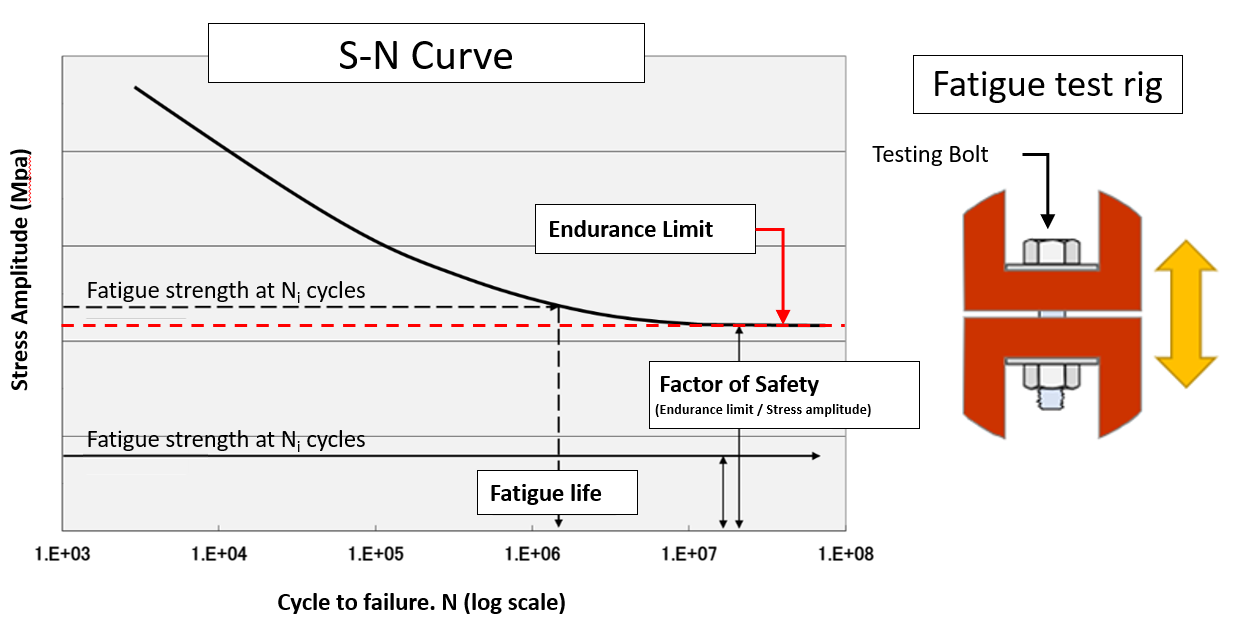
Why does loosening lead to fatigue failure?
Loosening leads to fatigue because the bolted joint is no longer able to absorb the external loads it was designed for. Clamp force is lost, preventing absorption into the parts, and increasing load in the bolt. Cyclic loading of the bolt is the underlying cause of fatigue failure.
When an external force in the axial direction is applied to a bolted joint, tension in the bolt (bolt load) increases and compression in the joint (clamp force) decreases. The clamp force is the compressional force holding the parts together. We can show the relationship between the bolt load and the clamp force with a bolted joint diagram (Shown below).
What is a Bolted Joint diagram?
A bolted joint diagram is a model to understand the deflective characteristics of a preloaded joint. Bolted joint diagrams can be used to analyze how an external load translates to increase in bolt load and decreased compression. The diagram is comprised of a joint compression line which is axially offset to the right which connects with the bolt extension line.

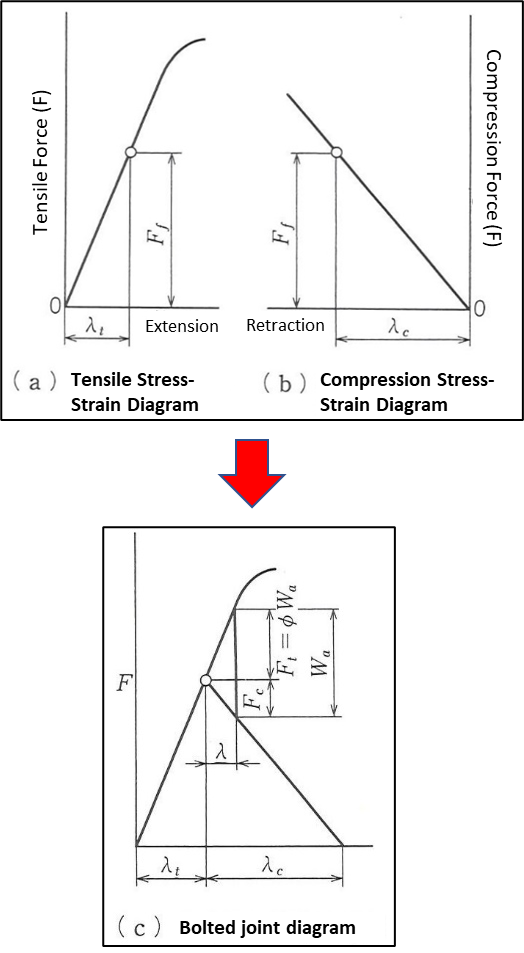
When working load is applied to the joint, clamped components are axially pulled in opposite directions. A proportion of the working load goes into the bolt (additional bolt load) , and the remainder to the joint (compression loss). This proportion between additional bolt load FSA and working load FA is called the load factor ( FA/FSA )
This is a Bolted Joint Diagram ↓

Dividing additional bolt load by the effective diameter of the bolt gives us Stress amplitude, shown in the above S-N Curve diagram (Y-axis).
If the stress amplitude (additional bolt load) does not exceed the endurance limit, we can theoretically say that bolt will not fail, for an unlimited number of cyclic loadings. Bolt designs which make the required considerations to reduce stress amplitude are considered effective at preventing fatigue failure.
On the contrary, if the stress amplitude exceeds the endurance limit, the bolt will break after a certain number of cycles. The breakage cycle can be predicted with the S-N curve.
What happens if preload is lost?
Case 1) Example of a safely designed bolted joint
In the below example, we assume no loss in preload (No loosening).
- ・Joint compression still remains after loading. (About half)
- ・Clamped interface stays completely engaged
- ・Stress amplitude is lower than endurance limit
⇒ Does not fatigue

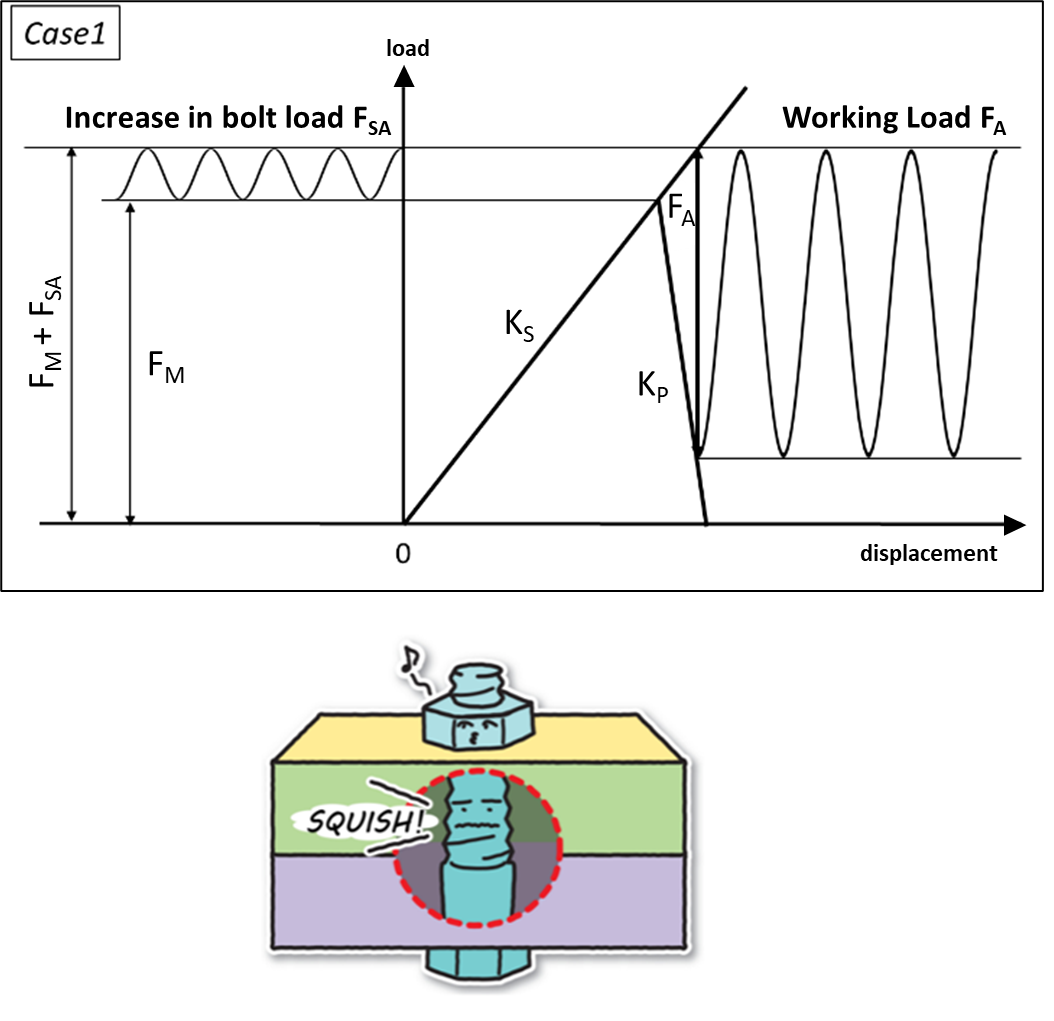
Case 2) Example of a badly designed bolted joint
The bolt has loosened but external loading is the same as Case 1).
- ・Joint compression is completely lost when loaded
- ・Clamped interface disengages when loaded
- ・Stress amplitude exceeds the endurance limit
⇒ Bolt will fail from fatigue
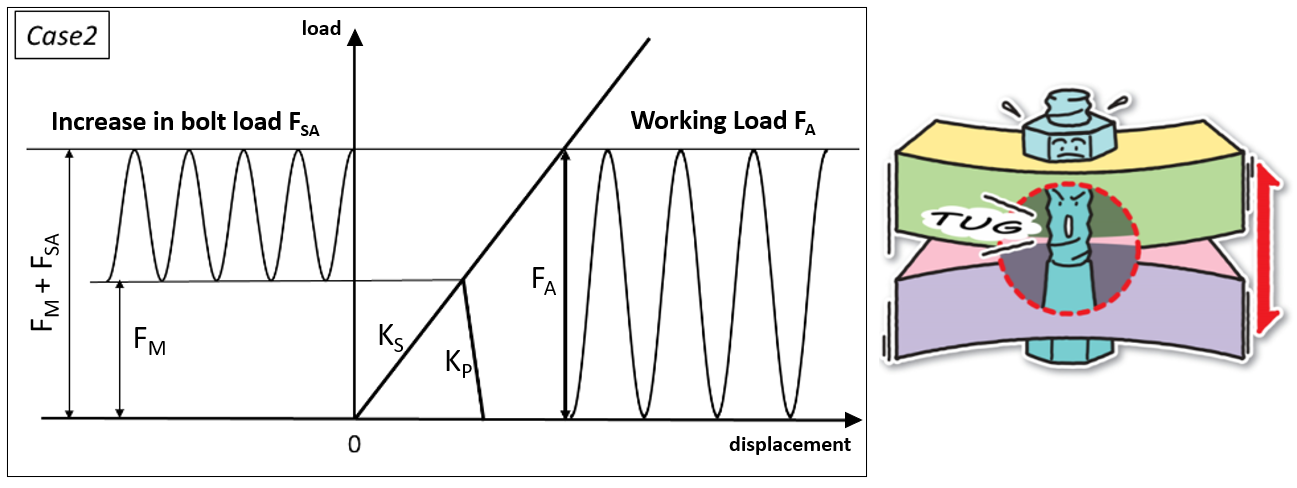
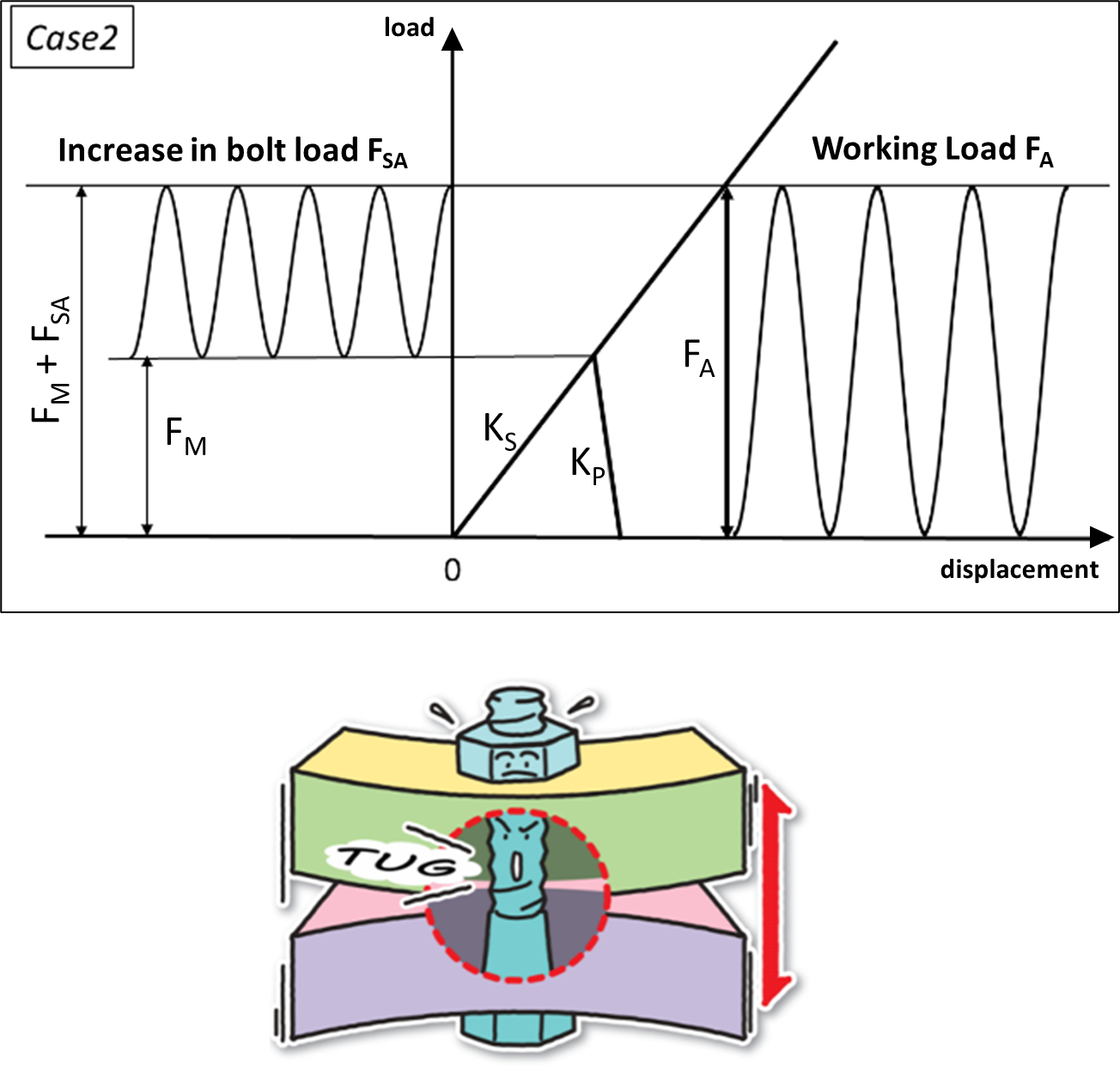
Sequence of events until fatigue failure
Joints subjected to cyclic loading → Bolt loosens → Loss in preload → Loss in Joint compression → Disengagement of Clamped interfaces → Additional bolt load → Stress amplitude exceeds endurance limit → Fractures occur in bolt → Bolt breaks
If the clamped interfaces disengage during external loading, compression in the joint is lost and all external load is applied to the bolt. Cyclic loading where interfaces disengage almost always leads to premature fatigue failure. However external loading that doesn’t cause disengagement of the clamped interfaces can still lead to fatigue failure. In this case, load is partially applied to the bolt (additional bolt load) and the clamped parts(decrease in compression). Decreasing the load applied to the bolt so that stress amplitude does not exceed the endurance limit will directly prevent fatigue failure.
In order to do this, we need to know how the proportion of load applied to the bolt is determined. The following equation: FSA = W2 x λ. shows the relationship between additional bolt load. FSA and Working load. W2.
To reduce the proportion of load put on the bolt, the load factor λ should be reduced. As an example, if the load factor is 0.2, 20% of the working load is converted to additional bolt load. For real Bolt designs, values between 0.2 and 0.3 are considered for the load factor. λ.
How to reduce the reduce the proportion of load applied to the bolt?
- ・Increase the length of the bolt, while decreasing nominal diameter
- ・Increase the number of bolts clamping the assembly
- ・Reduce preload variance
What is the endurance limit of a Hexagon Bolt M16
The endurance limit of a hexagon bolt M16x2.0 Class 5.8 was evaluated with fatigue failure testing. Separate tests for stress frequencies between 10 ~ 60 Mpa were undergone sequentially. The resulting endurance limit of the bolt was found to be approximately 10Mpa.
Purpose
・To find out the point at which working load will cause our fastener to fail from fatigue (Endurance limit).
・To draw the S-N graph with the fatigue life obtained for each stress amplitude. Using the S-N curve, the number of cyclic loads the joint will last given a particular working load can be calculated. The load factor is used to convert between stress frequency (half of the additional bolt load) and working load.
Testing Conditions
Testing bolt: M16x2.0 Strength Class 5.8 w/ Hot Dip Galvanized Coating
Preload: 44kN (Tensile strength 280MPa, 70% of Yield Stress)
Stress Amplitudes: 10, 20, 30, 40, 50, 60Mpa. (Total of 6 fatigue tests)
Relation between increased stress amplitude and preload loss
This test does not undergo test with various preloads to evaluate the effect of preload loss on bolt fatigue. However, the effect of preload loss on bolt fatigue can be understood indirectly by understanding the relationship between preload loss and the working load. If preload is lost, the working load will cause a larger increase in bolt load and larger loss in compression on the clamped parts. The amplitude of increased bolt load is equivalent to the stress amplitude. Therefore, we can understand the effect of preload loss by changing the stress amplitude directly.
We give a hypothesized preload loss for each stress amplitude to be tested,
Stress amplitude: 10, 20, 30, 40, 50, 60 Mpa.
Preload loss: 7%, 14%, 21%, 29%, 36%, 43%
This lets us estimate the amount of loosening required for the joint to be susceptible to fatigue.
Test Results
The bolt will not fatigue for Stress amplitudes of 10Mpa or below (endurance limit). Also for preload loss of 7% or less, the bolt will hypothetically not fail from fatigue (according to . We can also state that the bolt should not fail for preload loss of 7% or less. However, preload loss above 14% are vulnerable to fatigue failure after a certain number of cycles.
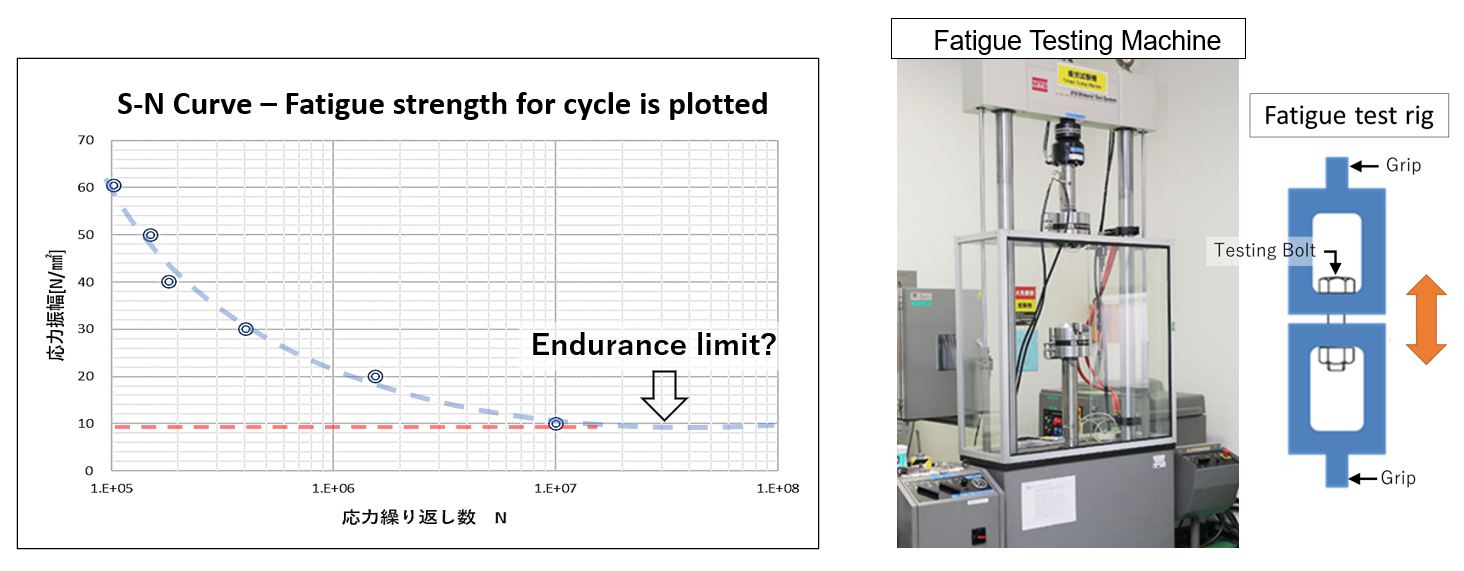
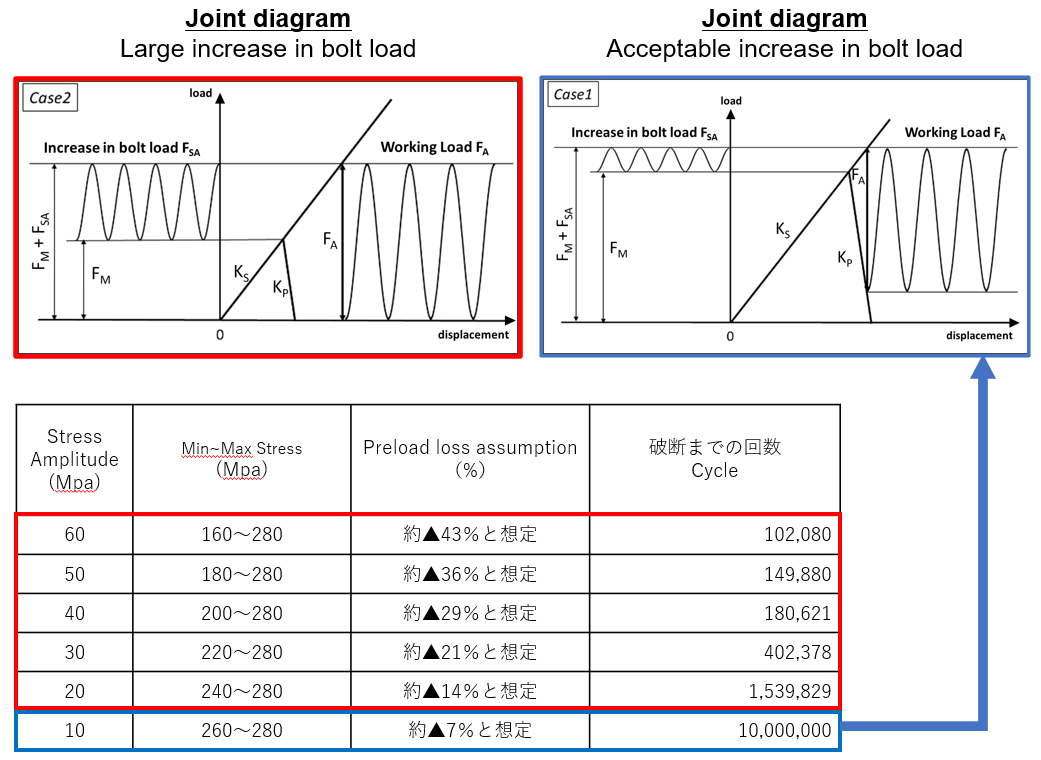
Conclusion
The larger the stress amplitudes, the earlier a bolt will fail from fatigue. Even if the working load (exterior forces) are held constant, loss in preload leads to larger stress amplitudes eventually fatiguing the bolt.
Why does fatigue failure occur?
Fatigue failure occurs when a bolt is installed with a lack of preload, or a lack in preload occurs after installation.
Next are 4 reasons why bolts fatigue.
1. Cyclic loading causes the bolt to come loose..
2. The bolt is not installed properly.
3. Forgetting to torque the bolt.
4. Inadequate joint design.
Even when using a torque wrench, Preload will typically scatter between 1.4 to 3 times, around the intended preload. This can be due to a great variance in Contact surface roughness for the bearing surface, threads flanks and bolt head. The contact surface roughness and other factors are usually expressed with the Torque coefficient to understand how much torque will be converted to preload. (T=kdf) Another factor behind preload scatter are torqueing tools. Different variations of Torqueing tools have different errors of accuracy. Click type torque wrenches (between 3 and 5%), pneumatic torque wrenches, etc. .
In order to prevent fatigue failure of bolted joints, correct preload must be applied and great care must be taken to ensure that preload is not loss during operation. In contrary to this, real life situations and experience tell us that applying correct preload is difficult and sometimes impossible. For example, many railway maintenance engineers are not equipped with torque wrenches. In these situations, it is vital that correct measures are taken to avoid preload lost and extend fatigue life.
 Chinese
Chinese Korean
Korean Japanese
Japanese